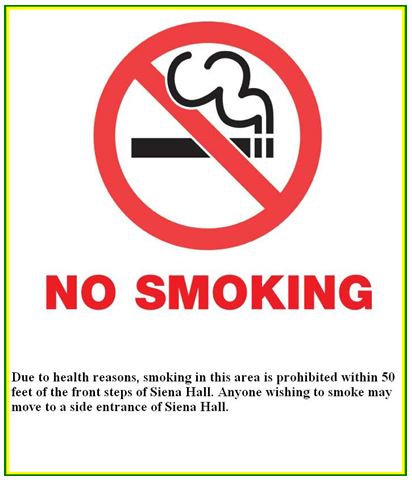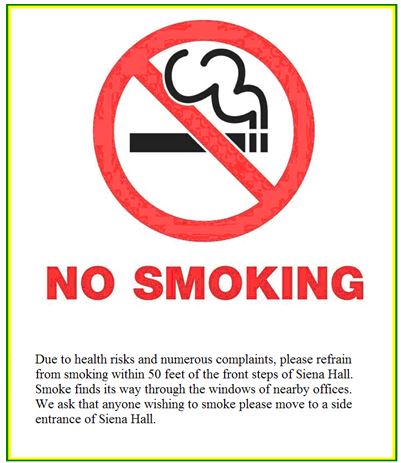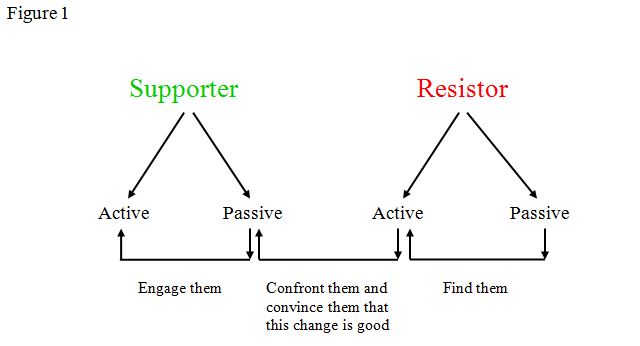Siena College: Change Management In Action
Introduction:
The Office of Institutional Effectiveness at Siena College has hired our team to focus on change management and work with them to find a solution to the problem discussed below. Our main contact within the office is Penny Brunner, the Assistant Vice President for Academic Affairs. The Office of Institutional Effectiveness is responsible for strategic planning, institutional research, administrative assessments, as well as accreditation at Siena College. In order to best serve our client, we have worked closely with them to customize all of our plans to their needs; everything listed below has been discussed and approved by our client.
Underlying Problem:
The presenting problem was that people were smoking on the front steps of Siena Hall and that the smoke was coming through the windows of the Office of Institutional Effectiveness. This was preventing Penny Brunner and her fellow office members from being able to open their windows to get fresh air. As we spoke with Penny and her colleagues, our group filled in the pieces of the diagnostic puzzle to ensure that we had obtained all of the necessary, preliminary information. Penny’s statement gave us part of the business importance aspect of the puzzle; she cannot open her windows for fresh air because of the smoke. In addition, we gathered that the smoking problem presents a health risk due to second-hand smoke, creates a confidentiality issue because the smokers can hear anything that goes on in Penny’s office, and creates a negative perception of Siena since Siena Hall is considered the face of the college. The behavior gap was that smokers should move to a different area, away from the front steps of Siena Hall and possibly out of sight if they would like to smoke. In regard to the explanation aspect of the puzzle, we believe that the lack of a non-smoking law at Siena, combined with the presence of ash trays on the front steps is promoting smoking in that area. Our first idea was to pass a non-smoking law for the entire college; this idea was thrown out as soon as we discovered, through two weeks of observation, that only a small area was being affected by the issue. Our expectation was that smokers no longer smoke on the front steps of Siena Hall at all after the implementation of our solution.
Solutions Considered:
The first solution that our group considered was to implement a campus-wide law against smoking. After observing the smoking problem in action at random times for a period of two weeks, we determined that the problem existed only on the front steps of Siena Hall. We felt that a campus-wide law would still be the most effective solution regardless of the size of the problem, so we created a list of every person and department that might be able to help us. We first spoke with Steven Archer, President of Student Senate. He stated that he and the members of the senate had tried to put a non-smoking law into place last year, but that Siena’s administration was unwilling to do so. We then approached the secretary of Father Mullen in order to schedule an appointment with him in the hope of getting his opinion on the issue; Father Mullen refused to meet with us for even ten minutes, but gave us no reason why. Next, we entered the Human Resources Office. We explained the details of our class and of the smoking issue before asking about the feasibility of a campus-wide law. The department consensus among the three people we spoke with in the Human Resources Office was that we could not create the law without the approval of Father Mullen. Consequently, we scratched this solution off our list and moved on to our second-best idea.
Our second idea had two parts: put non-smoking signs up in the windows of both the Department of Institutional Effectiveness and the Office of the President and remove the ash trays from the front steps of Siena Hall. First, we emailed Ed Travis, the Assistant Director for Services. He is part of the Facilities Management Office and would be able to tell us whether or not the ash trays could be removed. Our first email gave Mr. Travis a brief synopsis of the smoking issue and asked if our group could meet with him to discuss the possible removal of the ash trays as a supporting action in our solution (posting non-smoking signs). Mr. Travis replied that he was too busy to meet with us and that he would need to schedule any meetings weeks in advance. One week later, we dropped by his office hoping to speak with him, but he was not there. We resorted to leaving him a voicemail that contained the same information as the email we had sent, but instead of asking for a meeting, we asked for a yes or no answer on whether or not he could remove the ash trays; this way, we would not be wasting his time by meeting with him. Mr. Travis never responded.
During the time in between our interactions with Mr. Travis, our group created a sign that we thought we could put up in both the Department of Institutional Effectiveness and the Office of the President. The sign read, “NO SMOKING. Due to health reasons, smoking in this area is prohibited within 50 feet of the front steps of Siena Hall. Anyone wishing to smoke may move to a side entrance of Siena Hall.” See below:

We felt that by having the most important reason for the desired change under the no smoking phrase, faculty smokers will be more likely to understand why smoking in this area is a problem and why they need to move; we expected this to unfreeze the current behaviors of the faculty smokers. However, we questioned the use of the wording of the sign because it suggested that a campus-wide non-smoking law was in place even though no such law existed. So, we edited the wording to state: “NO SMOKING. Due to health reasons and numerous complaints, please refrain from smoking within 50 feet of the front steps of Siena Hall. Smoke finds its way through windows of the nearby offices. We ask that anyone wishing to smoke move to a side entrance of Siena Hall.” See below:

We showed the updated sign to Penny Brunner, and she approved of it. We then showed the sign to the secretary of the President, who informed us that we could not put up any signs without first obtaining approval from the Human Resources Department. The members of the Human Resources Department informed us that they had no power in matters of this nature; they suggested speaking with John Dierna, Director of Campus Programs and Student Activities. John Dierna was not available, so we scheduled an appointment with him for the following day. In the mean time, we sent a brief synopsis of the smoking issue and the proposed sign to Sandra Casey, College Counsel (Siena’s attorney), asking her to check the wording of our sign. Mr. Dierna met with our group and stated that we could not post the sign, so we emailed Ms. Casey and thanked her for her help. Sadly, we again were not able to put our solution into place.
Proposed Solution:
After exhausting our list of possible solutions for the smoking problem, our group has generated one final idea. We feel that Penny Brunner needs to approach the smokers when they smoke outside of her window. Ms. Brunner originally told our group that she felt uncomfortable approaching the smokers, but we see this action as the only viable solution we have left. We first plan to convince Ms. Brunner that the problem she presented us with is still valid and can still be solved. Second, we must speak with Ms. Brunner about what she can say to the smokers. Third, we plan to volunteer one or two of our group members to approach the smokers with her in an attempt to lead her through the change. Penny and the two volunteer group members will start a dialogue with each of the smokers. In a courteous and respectful manner, Penny and the two volunteer group members will make the smokers aware of both their close proximity to the Office of Institutional Effectiveness and the concerns that Penny has (confidentiality, second-hand smoke, etc.). We realize that each smoker will receive our criticism differently no matter how polite we are, so Penny and the two volunteer group members will need to adapt their dialogue on the spot to fit the reaction of each individual smoker. Because of the need for this adaptation, it is important that we be prepared for any of the four possible reactions. Having said that, each possible reaction of the smoker is explained in detail below, as well as our response to those actions.
Leading Change:
The proposed solution will impact the members of the Office of Institutional Effectiveness members and any individuals that smoke on the front steps of Siena Hall. As mentioned earlier, there are approximately five smokers, some of whom smoke multiple times per day. None of the members of our group know any of the smokers that we have observed smoking in front of Siena Hall, so we are unable to gauge their reactions to our proposed solution. There are four possible reactions to the change: active support, passive support, active resistance, and passive resistance. Our mission is to confront each of the smokers and move them up one notch on the support-resistance scale. See below.

If Penny and the chosen group members were to approach an active supporter, the active supporter would listen to and attempt to understand our concerns. The active supporter would then likely acknowledge our concerns as a reasonable problem, and move to a different area. Also, this person would educate other faculty members on the issue and attempt to convince them to make our requested change as well. The active supporter requires no response from us. We can however, thank them for understanding our situation and moving, and ask them to speak with other faculty smokers about moving as well.
A passive supporter would probably listen to our concerns and then move to a different area without saying much. This person would then smoke in a new area, away from the windows. Lastly, a passive supporter would keep to himself, not speaking with other faculty members about moving to a different area to smoke. When we notice passive support, we need to attempt to make the smoker comfortable enough so that he voices his concerns. We can then gently encourage him to become more active in our cause by suggesting things he can do to help; speaking with other faculty smokers would be one example, if he feels comfortable doing this.
An active resistor would consider our approach hostile. The active resistor may cut-off either Penny or the chosen group members before they can even finish voicing their concerns. The active resistor would first refuse to smoke in a different area. After deciding not to move, an active resistor would then create reasons why he should not have to move. He would then complain to other faculty members about the requested change, citing all of the reasons why he refuses to move and why should not have to move; he would also attempt to sway other faculty smokers to resist the change as well. Lastly, it’s very possible that an active resistor may go to the Human Resources department of Siena College and ask if there is any institutional policy against smoking in front of Siena Hall, where they would find there is no actual policy to support the requested change. The active resistor may complain about us approaching him as well. Our response to the active resistor must address his concerns rationally and logically. We must explain or reiterate why we are implementing the change; if we can show that his smoking affects multiple people, we might be able to sway his opinion and move him from active resistance to a neutral position.
If Penny and the chosen group members were to approach a passive resistor, he would likely listen to our concerns and then walk away without saying a word. Then, he would do one of two things: return to exact same area after we left or return to approximately the same area but out of sight. This type of resistor does not want confrontation, so the second option is more likely. This sneaky method prevents faculty members from the Office of Institutional Effectiveness from being able to see him. A passive resistor may say that he will move when approached, however over time he will likely continue to smoke in the same area. Furthermore, a passive resistor will keep to himself, meaning that he will not speak with other faculty smokers about the smoking issue. Our response to a passive resistor would be to encourage him to feel comfortable voicing his concerns; we must not act negatively or defensively when he responds, so as not to stifle his feedback.
Studies have shown that a change agent (the person attempting to implement a change) must have the active support of twenty percent of people involved in a given situation in order for a solution to be successful. In this case, we need the support of one faculty smoker; this seems reasonable so long as the faculty members actually speak with one another. While we do this, we also need to try to move each smoker one notch to the left on the support-resistance scale (See picture above). In doing this, we can ensure the greatest chance of success.
Demonstrating Success:
In order to measure our success, we plan to do two things. First, we will have the members of the Office of Institutional Effectiveness keep a running tally on the number of faculty smokers smoking in front of Siena Hall we speak with all of the smokers. Second, the members of our group counted cigarette-butts at 4:30 pm from April 4th to April 10th, a total of seven days; we have discovered that there is an average of 8 cigarette-butts per day in the ash trays on the front steps of Siena Hall. As soon as we implement our solution, we will again begin counting the numbers of cigarette-butts in the ash trays at 4:30 pm for another seven days in order to determine how successful our solution was. If there is no significant change in the average number of cigarette-butts by the seventh day, we will continue counting for an additional week; this will ensure that we have confronted all of the smokers and that we have given our solution enough time to take effect. At the end of our tracking-period (either one or two weeks), we will meet with the members of the Office of Institutional Effectiveness and analyze whether or not our solution was successful. We define success as eliminating the occurrence of smoking completely from the front steps of Siena Hall. If the solution is successful, our work is complete. If the solution does not succeed, we will attempt to implement one final solution. However, seeing as the end of the semester is rapidly approaching, we may not have time to put in another solution if our first one fails.
